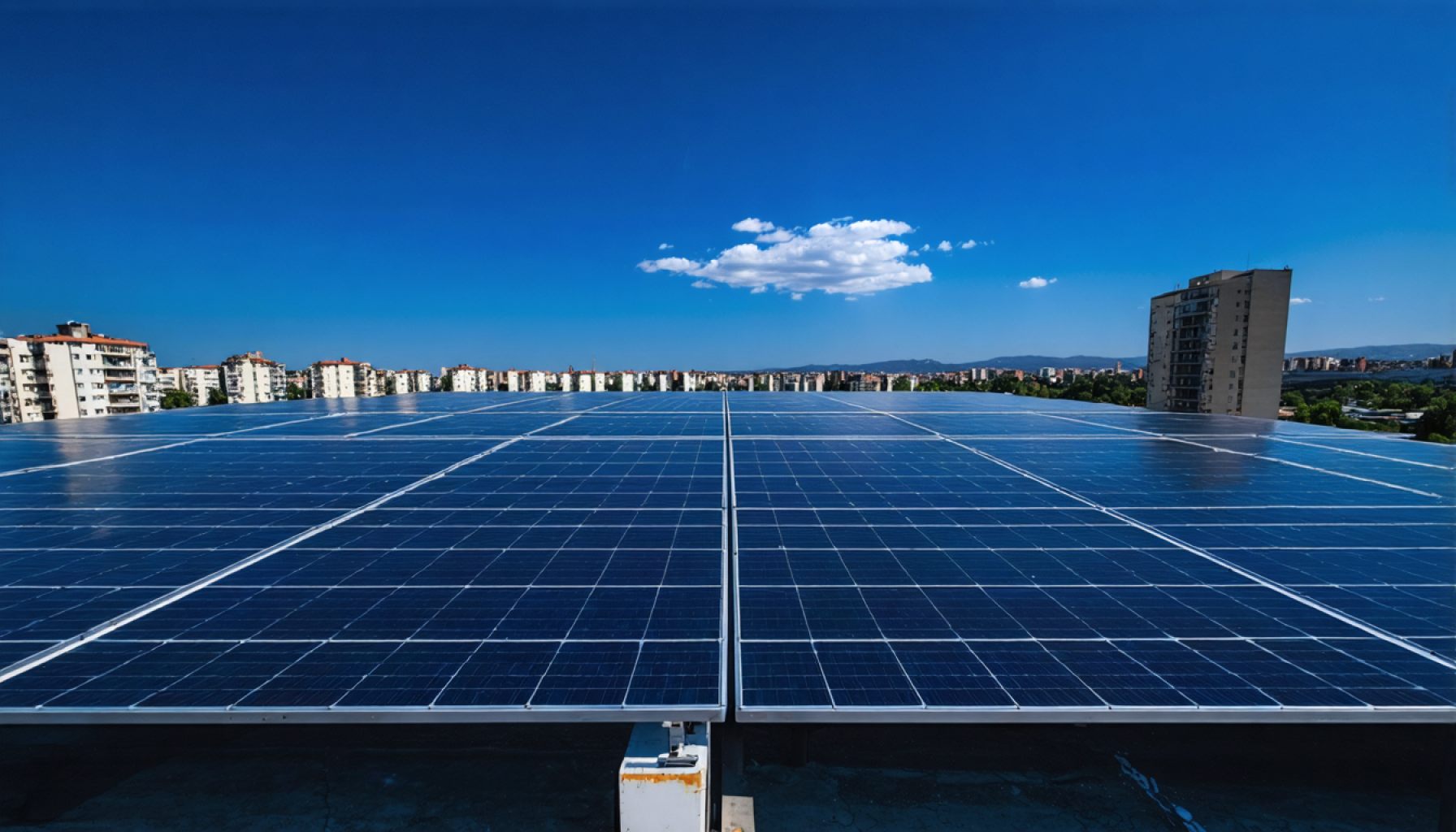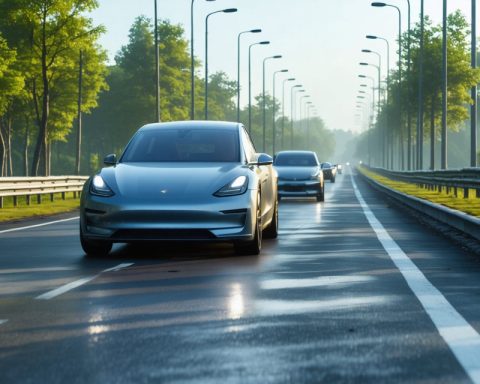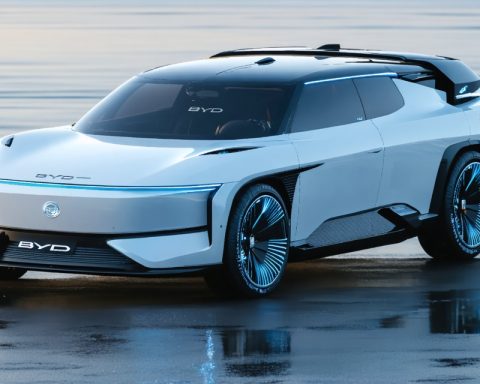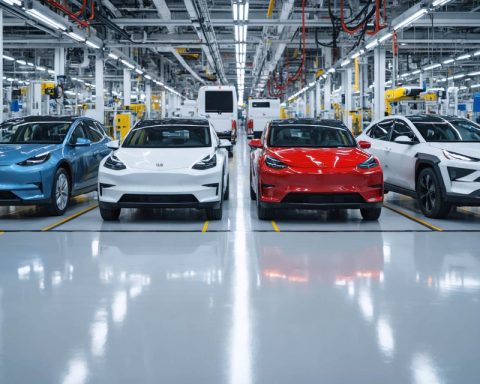- Solar energy is transforming cities into sustainable powerhouses, addressing climate change and energy demands.
- Urban architecture is increasingly integrating solar technologies, with skyscrapers utilizing photovoltaic cells to become partially or fully self-sufficient.
- Solar innovation extends beyond rooftops, featuring solar canopies over parking lots and integration into public transport systems.
- Community solar gardens offer shared opportunities for those in urban apartments to invest in and benefit from solar energy.
- The adaptability of solar energy allows seamless integration into various urban settings, accelerating the transition to a greener future.
- Solar energy promises reduced reliance on fossil fuels, lower emissions, and enhanced energy security, paving the way for eco-conscious urban spaces.
As the sun rises each morning, casting a golden hue over skyscrapers and bustling streets, it does more than just signal the start of a new day. Solar energy stands ready to illuminate urban landscapes, transforming cities into sustainable powerhouses. With the planet facing the dual pressures of climate change and growing energy demands, the shift to solar power is not just a trend—it’s an imperative.
Envision a city where rooftops gleam with blue-tinted panels, drinking in sunlight and converting it into clean, renewable energy. This imagery is rapidly becoming reality, as an increasing number of urban planners and city officials integrate solar technologies into metropolitan infrastructures. The benefits ripple through urban environments, offering not only economic savings but also reducing carbon footprints and fostering energy independence.
Solar Skyscrapers
In the heart of our cities, skyscrapers stand as testaments to human achievement, touching the sky with their steel and glass façades. Today, they also symbolize our commitment to sustainability. Many of these towers now integrate photovoltaic cells directly into their designs, blurring the line between architecture and energy production. This innovation enables skyscrapers to power themselves partially or fully, setting a stunning example of eco-friendly design.
Beyond Rooftops
While rooftop installations remain pivotal, solar energy transcends traditional boundaries. Urban planners deploy solar canopies over parking lots and integrate panels into public transport systems. Bus stops with solar-powered lighting, trains powered by solar-fed grids, and even benches in parks that allow you to recharge your devices with solar energy are becoming commonplace.
Community Solar Gardens
For those in dense urban apartments or shaded areas where personal solar units are impractical, community solar gardens offer an elegant solution. These shared solar arrays allow individuals to invest in solar energy collectively, receiving credits on their utility bills proportional to their stake.
The beauty of solar energy in urban settings lies in its ability to offer adaptability. From sprawling megacities to smaller towns, the application of solar tech fits seamlessly with varying aesthetics and infrastructure needs. This adaptability ensures its integration into a diverse range of environments, accelerating the transition towards a greener future.
Embrace the future that solar energy heralds—it’s not just about harnessing the sun’s power; it’s about creating a cleaner, healthier urban ecosystem. As individuals and communities harness solar solutions, they take a significant step towards sustainability, proving that every sunbeam can indeed power a brighter future.
The takeaway is clear: each ray of sunlight that falls upon our cities is an opportunity. It’s a chance to reduce reliance on fossil fuels, cut down on emissions, and enhance energy security. Together, urban spaces can transform into vibrant models of eco-consciousness, leading the way in our collective journey towards a more sustainable world.
The Surprising Ways Solar Energy is Transforming Urban Spaces
Introduction
As cities continue to grapple with the challenges of climate change and escalating energy demands, solar energy emerges as a beacon of sustainable innovation. More than just a clean energy source, solar technology is redefining urban landscapes, inspiring new architectural designs, and enabling cities to become self-sufficient powerhouses. Here, we explore the untapped potential of urban solar energy, its real-world applications, market trends, and actionable insights for a sustainable future.
Emerging Trends in Urban Solar Adoption
The integration of solar technology into urban environments is accelerating, driven by several key trends:
1. Distributed Energy Generation: Urban areas are increasingly adopting distributed solar power systems, which allow for localized energy generation and reduce the strain on central grids. This decentralization not only provides reliability but also enhances energy security.
2. Energy Storage Solutions: The combination of solar panels with energy storage systems, such as batteries, ensures a steady energy supply even during cloudy days or nighttime. Advances in battery technology are making this option more feasible and cost-effective for urban infrastructures.
3. Net Zero Buildings: Companies and developers are striving towards creating net zero energy buildings that produce as much energy as they consume annually. These buildings rely heavily on integrated solar panels, efficient design, and smart energy management systems.
Key Applications of Solar Energy in Cities
Beyond the traditional rooftop solar panels, innovation in urban solar energy is creating new opportunities for sustainable infrastructure:
– Solar Carports and Charging Stations: Public and commercial parking lots are being converted into solar carports that provide covered parking and generate power for electric vehicle (EV) charging stations.
– Smart Street Lighting: Solar-powered street lights equipped with LED technology and smart sensors are being installed, reducing energy consumption and maintenance costs while enhancing urban safety.
– Solar Façades: Skyscrapers and office buildings are integrating solar façades, which not only generate power but also improve the insulation and aesthetic appearance of structures.
Market Outlook and Industry Growth
The global solar energy market is projected to continue its robust growth, with particular emphasis on urban installations. According to the International Renewable Energy Agency (IRENA), solar capacity needs to grow six-fold by 2050 to meet global climate goals. This rapid expansion is driven by decreasing costs, policy incentives, and the increasing viability of urban solar projects.
Challenges and Considerations
Despite the promising outlook, urban solar adoption faces challenges:
– Initial Investment: High upfront costs for installation and technology integration can be a barrier for some cities and businesses.
– Space Constraints: Dense cities often struggle to find sufficient space for solar installations, necessitating creative solutions like vertical panels or solar canopies.
– Policy and Regulation: Navigating local regulations and securing permits can be complex, requiring cooperation among government entities, businesses, and communities.
Actionable Recommendations
To harness the full potential of urban solar energy, consider these steps:
1. Assess Feasibility: Conduct a solar feasibility study to evaluate potential sites and energy output.
2. Explore Incentives: Research available government grants, tax incentives, and rebates to offset installation costs.
3. Engage Communities: Foster community involvement in solar projects through education and shared solar programs to increase buy-in and participation.
Conclusion
Solar energy offers a transformative opportunity for cities to enhance their sustainability credentials, reduce carbon footprints, and achieve energy independence. By embracing innovative solar applications, promoting supportive policies, and investing in cutting-edge technologies, urban areas can lead the charge toward a cleaner, greener future.
For further information, explore more on IRENA about renewable energy initiatives. Remember, each ray of sunlight offers a chance to brighten our cities sustainably.

















